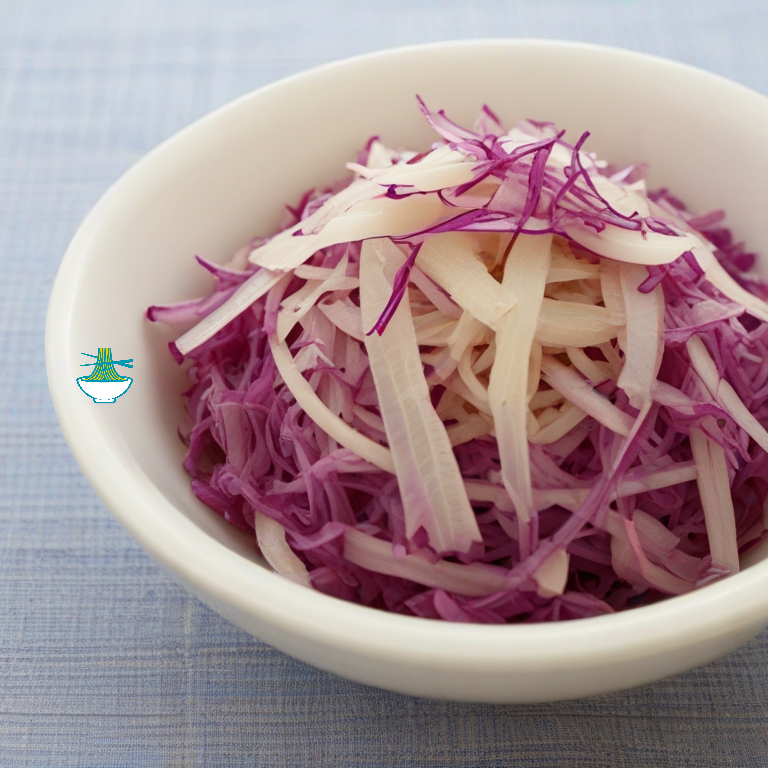Dive into the heart of German culinary heritage with our flavorful Sauerkraut. This beloved dish, originating from centuries-old fermentation techniques, combines finely shredded cabbage with a tangy blend of spices, resulting in a uniquely satisfying flavor profile. Whether enjoyed as a hearty side dish or a zesty topping, Germany's Sauerkraut offers a delightful harmony of sour and savory notes that elevate any meal. Experience the timeless taste of tradition with every forkful of this iconic German delicacy.
Ingredients:
- 1 head of cabbage (about 2 pounds)
- 1 tablespoon kosher salt (or non-iodized salt)
- Caraway seeds (optional, for flavor)
- Juniper berries (optional, for flavor)
- 1 quart (4 cups) filtered water

Instructions:
Prepare the Cabbage:
1- Remove any wilted outer leaves from the cabbage.
2- Rinse the cabbage under cold water and pat it dry.
3- Cut the cabbage into quarters and remove the core.
4- Finely shred the cabbage using a sharp knife or a mandoline slicer.
Salt the Cabbage:
1- In a large mixing bowl, place the shredded cabbage.
2- Sprinkle the kosher salt over the cabbage.
3- Using clean hands, massage the salt into the cabbage thoroughly. This helps to break down the cabbage and release its natural juices.
Pack the Cabbage:
1- Transfer the salted cabbage and any accumulated juices into a clean glass or ceramic fermentation vessel.
2- Use a wooden spoon or your hands to pack the cabbage tightly into the vessel, removing any air pockets.
Add Flavorings (Optional):
1- Sprinkle caraway seeds and juniper berries over the packed cabbage for added flavor. Adjust the quantity according to your preference.
Weight the Cabbage:
1- Place a weight on top of the cabbage to keep it submerged in its own liquid. This can be a clean, heavy plate or a fermentation weight specifically designed for this purpose.
Ferment the Sauerkraut:
1- Pour filtered water over the cabbage until it is completely submerged.
2- Cover the fermentation vessel with a clean cloth or a lid with an airlock to allow gases to escape while preventing contaminants from entering.
3- Place the vessel in a cool, dark place with a stable temperature, ideally between 60°F to 70°F (15°C to 21°C).
4- Let the sauerkraut ferment for at least 1 to 4 weeks, depending on your desired level of sourness. Check the sauerkraut periodically and skim off any scum that may form on the surface.
Taste and Store:
1- Once the sauerkraut reaches your desired level of fermentation, taste it to ensure it has the right balance of flavors.
2- Transfer the sauerkraut into clean, airtight jars and store it in the refrigerator. Properly stored sauerkraut can last for several months, developing more depth of flavor over time.
Enjoy:
1- Serve the sauerkraut as a traditional side dish alongside German sausages, pork dishes, or incorporate it into various recipes for added flavor and nutrition. Guten Appetit!
Nutritional Values:
Here are the approximate nutritional values for the main ingredients in the authentic German Sauerkraut recipe:
Cabbage (1 head, approximately 2 pounds):
- Calories: 160
- Carbohydrates: 37 grams
- Fiber: 16 grams
- Protein: 8 grams
- Fat: 1 gram
- Vitamin C: 340% of the Daily Value (DV)
- Vitamin K: 880% of the DV
- Folate: 50% of the DV
- Calcium: 20% of the DV
- Iron: 10% of the DV
- Potassium: 25% of the DV
benefits:
- Rich source of Vitamin C, which supports the immune system and promotes healthy skin.
- High in fiber, aiding digestion and promoting gut health.
- Contains Vitamin K, essential for blood clotting and bone health.
- Good source of folate, important for cell division and DNA synthesis.
- Provides calcium and potassium, necessary for bone and muscle health.
Kosher Salt (1 tablespoon):
- Calories: 0
- Sodium: 4,800 milligrams (200% of the DV)
benefits: Provides sodium, essential for maintaining fluid balance and nerve function in the body.
Caraway Seeds (optional, for flavor):
- Calories: 22 (per tablespoon)
- Carbohydrates: 4 grams
- Fiber: 2 grams
- Protein: 1 gram
- Fat: 1 gram
benefits:
- Contains antioxidants and fiber, supporting digestive health and reducing inflammation.
- Provides a unique flavor and aroma to dishes.
Juniper Berries (optional, for flavor):
- Calories: 3 (per tablespoon)
- Carbohydrates: 1 gram
- Fiber: 0 grams
- Protein: 0 grams
- Fat: 0 grams
benefits:
- Rich in antioxidants, which may help protect cells from damage and reduce inflammation.
- Can aid digestion and have diuretic properties, promoting kidney health.
It's important to note that these values are approximate and can vary based on factors such as the specific variety of cabbage, the brand of salt used, and the quantity of optional flavorings added. Additionally, the fermentation process may alter some of these values slightly.


Comments